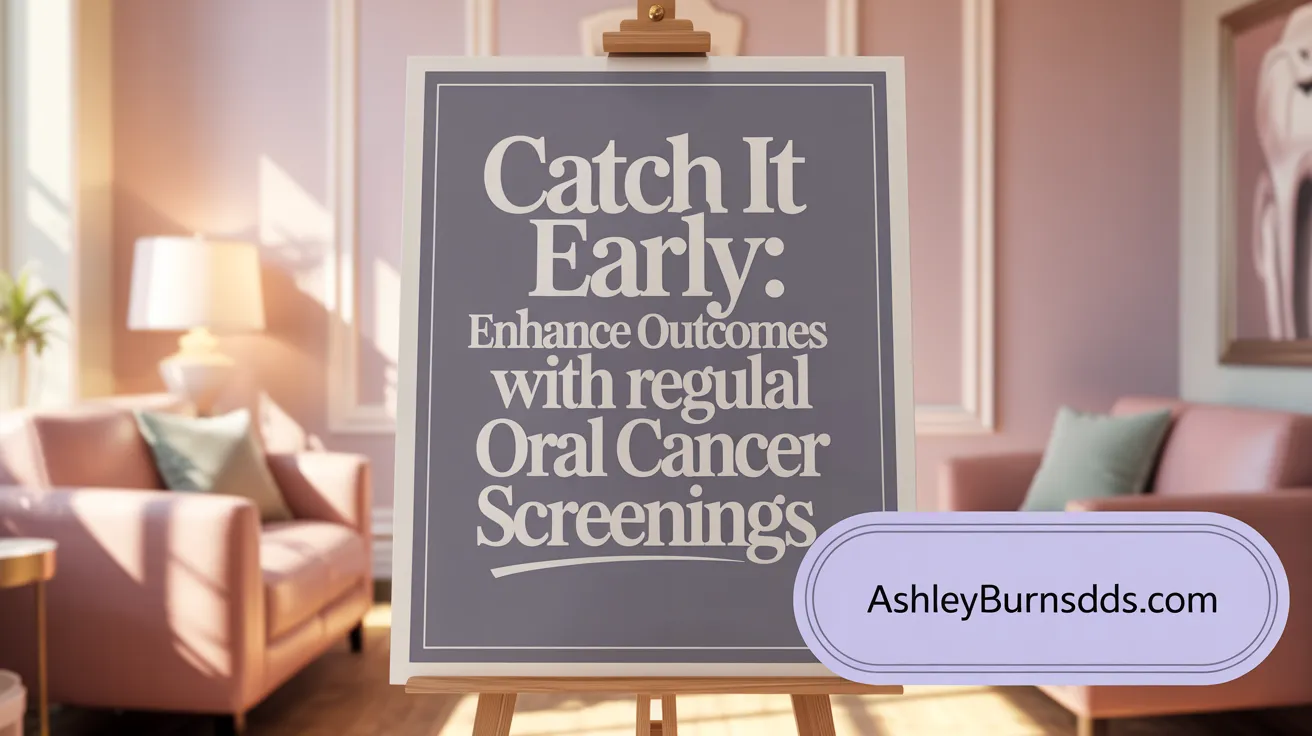Understanding Oral Cancer Screenings in Preventive Dentistry
Oral cancer remains a significant public health challenge with thousands of new cases diagnosed annually worldwide. However, many cases can be detected early or prevented through routine oral cancer screenings, an integral part of preventive dentistry. These screenings enable the identification of precancerous lesions and abnormalities before symptoms arise, vastly improving treatment outcomes and survival rates. This article explores the crucial role oral cancer screenings play within comprehensive dental care, the methods and guidelines followed, their impact across all age groups, and how patient education and oral hygiene contribute to reducing cancer risk.
The Vital Role of Oral Cancer Screenings in Preventive Dentistry

What is the importance and role of oral cancer screenings in preventive dentistry?
Oral cancer screenings are a fundamental part of preventive dental care, serving as a critical tool for early detection of cancers and precancerous conditions in the mouth. These screenings allow dental professionals to identify abnormalities such as sores, lumps, patches, or tissue discolorations in their initial stages, when treatment is most effective.
Routine screenings are usually quick, painless, and integrated into regular dental visits, involving visual and physical examinations of the mouth, throat, and neck. This proactive approach significantly enhances treatment outcomes, increasing survival rates from below 60% to over 85% when the disease is caught early (Importance of oral cancer screenings).
High-risk groups—such as smokers, heavy drinkers, and those infected with HPV—are particularly encouraged to undergo regular screenings. These assessments help in the early identification of potentially malignant disorders before symptoms appear, facilitating timely and less invasive treatments.
Research from regions like India and Taiwan demonstrates that organized screening initiatives can lead to substantial reductions in mortality—up to 81% (Oral cancer screening programs and mortality reduction). Incorporating these screenings into routine dental care underscores a preventive strategy that saves lives and decreases the overall health burden of oral cancer (Role of oral cancer screenings in preventive care).
In summary, oral cancer screenings are indispensable in the realm of preventive dentistry, enabling early detection, guiding prompt intervention, and ultimately enhancing patient survival and quality of life.
Procedures, Methods, and Guidelines in Oral Cancer Screening
 During oral cancer screenings, healthcare providers perform a comprehensive and systematic visual and tactile examination of the entire mouth, including the lips, tongue, gums, floor and roof of the mouth, to identify any suspicious areas such as lesions, lumps, or patches. This initial visual inspection is crucial for detecting early signs of abnormal tissue changes.
During oral cancer screenings, healthcare providers perform a comprehensive and systematic visual and tactile examination of the entire mouth, including the lips, tongue, gums, floor and roof of the mouth, to identify any suspicious areas such as lesions, lumps, or patches. This initial visual inspection is crucial for detecting early signs of abnormal tissue changes.
To enhance detection accuracy, clinicians often utilize adjunctive techniques. These may include special dyes like toluidine blue, which preferentially stain abnormal tissues, or fluorescence-based aids such as VELscope, which use special lighting to reveal tissue irregularities not visible to the naked eye. Additionally, exfoliative cytology and brush biopsies can be performed on areas that appear suspicious, enabling the collection of cells for laboratory analysis to determine whether the tissue is precancerous or malignant (Oral cancer screening procedures).
Risk factor assessment is an integral part of the screening process. Healthcare providers review medical history, including tobacco, alcohol, and HPV exposure, along with social habits and prior history of oral lesions. They also examine the neck for lymphadenopathy or swelling, which may indicate metastatic spread (Risk factors for oral cancer).
Follow-up protocols depend on the findings during examination. If suspicious tissue is detected, further steps include definitive diagnosis through tissue biopsy, referral to an oral surgeon or oncologist, and close monitoring. Since no screening method currently proves to reduce mortality universally, decisions to proceed with advanced diagnostics are made judiciously, considering patient-specific risk factors and clinical judgment (Oral cancer screening and mortality).
In summary, oral cancer screenings involve a combination of visual and tactile exams, the use of adjunctive technologies to improve detection, thorough risk assessments, and structured follow-up procedures to ensure early diagnosis and intervention, aligned with current guidelines and best practices (Oral cancer screening recommendations.
Early Detection: Improving Oral Cancer Outcomes and Preventive Impact

How does early detection impact oral health outcomes in the context of oral cancer?
Early identification of oral cancer significantly enhances the chances of successful treatment and long-term health. When detected at an early stage, oral cancer can often be treated with less invasive methods, such as smaller surgeries or targeted therapies, which preserve oral functions and appearance. Prompt diagnosis reduces the likelihood of cancer spreading or becoming more advanced, thereby decreasing the necessity for extensive treatments like radical surgeries or aggressive chemoradiation. This early intervention not only improves survival rates—often exceeding 85% when caught early—but also minimizes complications, fosters quicker recovery, and improves the patient's overall quality of life (Importance of Oral Cancer Screenings, Oral cancer screening benefits, Major Benefits of Oral Cancer Screening.
How do regular oral cancer screenings contribute to preventing oral cancer?
Routine screenings are a cornerstone in preventing the serious consequences of oral cancer by enabling early detection of suspicious lesions and precancerous conditions. These quick, painless examinations involve visual inspection and physical palpation of the mouth, throat, jaw, and neck to identify any abnormal signs such as sores, lumps, discolorations, or tissue changes. By regularly screening high-risk groups—such as tobacco users, heavy alcohol consumers, and those with HPV—healthcare professionals can catch potential issues before symptoms arise (Oral cancer screening procedures, Role of oral cancer screenings in preventive care).
Early detection through organized screening programs and routine dental visits allows for timely interventions, including biopsies and further tests, which can prevent the progression to invasive cancer. Modern advancements like fluorescence visualization tools and biopsy techniques improve diagnostic accuracy. Although current research continues to explore more precise technologies, routine screenings remain essential because they significantly contribute to reducing oral cancer incidence and mortality rates (Screening for oral cancer and diagnostic tools, Oral cancer screening frequency and recommendations). Effective early detection not only saves lives but also lessens the burden of more complex treatments, ultimately supporting better oral health outcomes (The role of oral cancer screenings in preventive care, Importance of routine oral cancer screenings).
Oral Health, Hygiene, and Education: Reducing Cancer Risk
Maintaining optimal oral health is a fundamental aspect of reducing the risk of developing oral cancer. Poor oral hygiene, characterized by chronic infections, inflammation, and gum disease, has been linked to an increased likelihood of oral carcinogenesis. Regular dental care practices such as brushing twice daily with fluoride toothpaste, flossing, and routine professional cleanings help control harmful bacteria and reduce inflammation. These measures not only preserve teeth and gums but also bolster systemic health, indirectly decreasing cancer risks (oral hygiene and cancer risk, Preventive dentistry basics).
Educating patients about recognizing early signs and symptoms of oral cancer is crucial for prompt diagnosis and treatment. Healthcare providers should advise individuals to observe for persistent mouth sores, lumps, or ulcers that do not heal within two weeks. Awareness of risk factors—such as tobacco and heavy alcohol use, HPV infection, sun exposure to lips, and family history—is vital. Patients should be instructed on self-examination techniques, including feeling the lips, cheeks, gums, and neck for lumps, and inspecting the mouth and throat using mirrors and focused lighting regularly (7 steps to preventing oral cancer, Oral cancer screening knowledge among dentists).
Providing accessible resources, visual aids, and brochures can enhance understanding and motivate routine screening. Routine dental visits are essential, as they allow health professionals to perform careful visual and physical examinations, often detecting abnormalities early before symptoms emerge. Early detection through such regular screenings significantly improves treatment success rates (Oral Cancer Screenings, Routine oral cancer screenings, Early detection benefits).
In summary, good oral hygiene practices and patient education form the cornerstone of oral cancer prevention efforts. They work synergistically to minimize inflammation, identify early warning signs, and encourage lifestyle modifications—such as quitting tobacco and moderating alcohol intake—that further decrease the likelihood of cancer development. A proactive approach involving education, routine check-ups, and good personal habits can save lives by catching oral cancer in its earliest, most treatable stages (Importance of oral cancer screenings, Preventive dentistry, Oral cancer screening frequency.
Integrating Oral Cancer Screenings into Comprehensive Preventive Dental Care Across Age Groups
 Oral cancer screenings are a vital component of comprehensive preventive dental care, systematically incorporated into routine dental visits to safeguard oral and overall health. During regular check-ups, dentists perform visual examinations and palpate oral tissues to detect early signs of oral cancer, such as suspicious sores, lumps, or discolorations. To enhance detection accuracy, advanced diagnostic tools like VELscope, fluorescence visualization, or salivary biomarkers may be employed, especially for high-risk patients.
Oral cancer screenings are a vital component of comprehensive preventive dental care, systematically incorporated into routine dental visits to safeguard oral and overall health. During regular check-ups, dentists perform visual examinations and palpate oral tissues to detect early signs of oral cancer, such as suspicious sores, lumps, or discolorations. To enhance detection accuracy, advanced diagnostic tools like VELscope, fluorescence visualization, or salivary biomarkers may be employed, especially for high-risk patients.
These screenings are conducted opportunistically, seamlessly fitting into standard preventive practices that include oral exams, risk assessments, and patient education. The integration not only facilitates early detection but also promotes a holistic approach to health, emphasizing the connection between oral health and systemic well-being (oral hygiene and cancer risk).
Why are age-specific screenings important?
Early detection significantly improves treatment outcomes across all age groups (Importance of oral cancer screenings. While the risk of oral cancer increases from middle age onward, younger populations are not exempt, particularly due to HPV-related cases (oral cancer risk factors). Routine screenings involve visual and tactile assessments, with adjunctive technologies used as necessary (Oral cancer screening frequency.
In pediatric patients, the focus shifts slightly to developmental assessments, education about risk factors such as tobacco, alcohol, and HPV, and establishing good oral hygiene practices (Children's preventive dental care, Role of pediatric screening and education). For adolescents, early screening and education lay the groundwork for long-term health, helping to prevent the development of malignant conditions later in life (oral cancer early detection).
Role of pediatric screening and education
Pediatric screenings are crucial for adolescence, integrating oral health education about healthy habits and risk factors. Monitoring growth and development helps identify any abnormalities early while instilling lifelong awareness of oral health's importance (Oral cancer screening in children).
Usage of advanced diagnostic tools
Technologies such as VELscope fluorescence and salivary diagnostics are gradually becoming part of routine screenings, especially in high-risk groups (Advanced Dentistry of Georgetown, Oral cancer screening technology). These tools can reveal early tissue changes undetectable by visual inspection alone, increasing the likelihood of early intervention (screening methods overview).
In conclusion, integrating oral cancer screenings into preventive dental care across ages enables early diagnosis, enhances treatment success, and fosters healthy habits from a young age, ultimately reducing the burden of oral cancer worldwide (Oral cancer screenings and preventive care).
Ensuring Lifelong Oral Health Through Routine Cancer Screenings
Oral cancer screenings constitute an indispensable element of preventive dentistry, offering a practical, efficient means to identify early signs of malignancy and improve patient outcomes. Through regular screenings, patients receive timely interventions that often translate into higher survival rates and less invasive treatments. Comprehensive preventive care encompasses not only clinical examinations but also patient education, risk factor modification, and maintaining optimal oral hygiene. Incorporating screenings across all age groups—from pediatric to elderly patients—facilitates broad-spectrum prevention, addressing specific risks relevant to each demographic. Continued advancements in screening techniques and integration with routine dental care promise to keep oral cancer detection at the forefront of dental health services, reinforcing the critical role these screenings play in safeguarding long-term oral and overall health.
